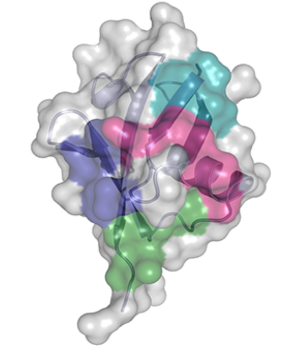Kulathu Lab
Ubiquitin Signals:
The functional outcome of ubiquitylation depends on whether ubiquitin is attached to substrate proteins as a monomer or as polyubiquitin chains. Thus substrates can be modified with different types of ubiquitin modifications: a single Ub on one substrate lysine (monoubiquitin), multiple substrate lysines (multi-monoubiquitin) or polyubiquitin chains. Topologically distinct polyubiquitin chains of 8 different types can be assembled, as each of the 7 lysine residues (K6, K11, K27, K29, K33, K48 and K63) and an N terminal methionine (M1) in ubiquitin can serve as acceptors for another ubiquitin. In addition to these homotypic polyubiquitin chains, we and others have recently shown that polyubiquitin exists as heterotypic chains made up of branched and mixed linkages.
Proteins with ubiquitin binding domains (UBDs) make up the “reader” module and translate these different modifications into specific outcomes. Readers for some of the linkage types are yet to be discovered, thus limiting our understanding of how different linkage types are utilised. Mechanistically, it is fascinating that small UBDs such as NZFs and UBA domains employ different strategies to discriminate the different types of ubiquitin signals, all of which are made up of the same building block - ubiquitin.
We therefore want to understand the nature of the ubiquitin signal produced and the principles by which different ubiquitin signals are decoded and integrated by UBD containing proteins that determines whether the ubiquitin modification signals destruction of the tagged protein.
Our published work in this area:
Kristariyanto YA, Abdul-Rehman SA, Weidlich S, Knebel A, Kulathu Y. (2017) "A single MIU motif of MINDY‐1 recognizes K48‐linked polyubiquitin chains". EMBO Reports DOI 10.15252/embr.201643205
Kristariyanto YA, Abdul-Rehman SA, Campbell DG, Morrice NA, Toth R & Kulathu Y (2015) “K29-selective ubiquitin binding domain reveals structural basis of specificity and heterotypic nature of K29 polyubiquitin”. Molecular Cell 58(1): 83-94 Abstract
Kristariyanto YA, Choi SY, Abdul-Rehman SA, Ritorto S, Campbell DG, Morrice NA, Toth R & Kulathu Y (2015) “Assembly and structure of Lys33-linked chains reveals distinct conformations”. Biochem Journal 467(2): 345-52 Abstract
Back to Research Interests

